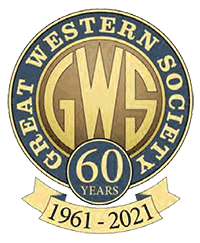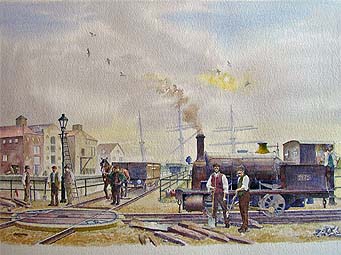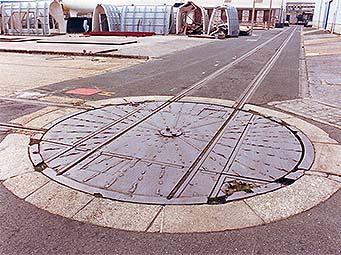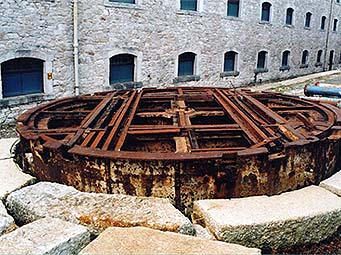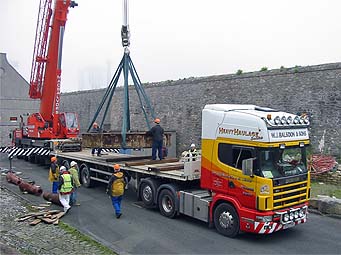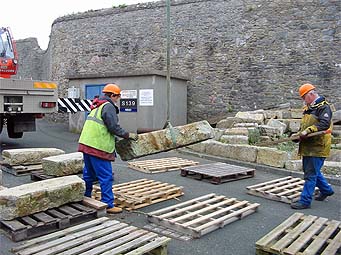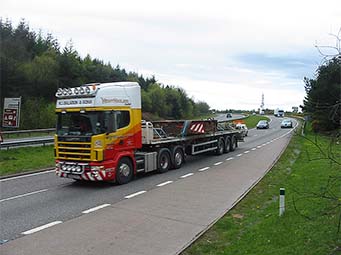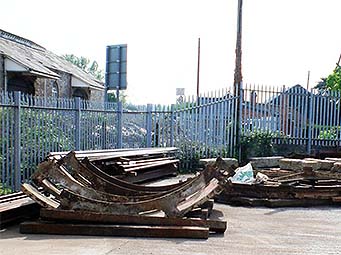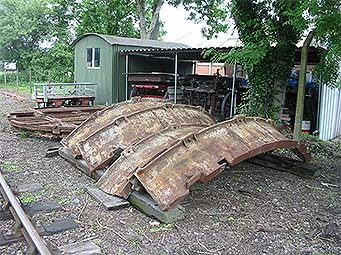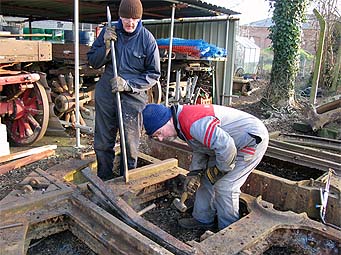Broad Gauge Turntable project
Introduction
The Society has been fortunate to have obtained a near complete example of a broad gauge turntable, thought to have been manufactured for the Cornwall Railway circa 1868, and originally installed within Devonport Royal Dockyard.
The turntable had been stored at the Royal Dockyard but, having been purchased by the Great Western Society, was dismantled and transported to Didcot where it has been restored as an addition to the current Broad Gauge exhibits.
History
The origin of this table is far from clear. It was allegedly once located to the north-east of No. 3 basin in the North Yard, before being relocated to the South Yard at some time following the Second World War. However no documentary evidence has been found to support, or indeed contradict, this.
If it was indeed once in this location, then the earliest broad gauge lines in the dockyard were laid in that area in 1860. It is known that “on 7th March of that year 6,750 feet of rails were ordered from Ebbw Vale at £10 per ton. A single line of rails laid to the broad gauge of 7 feet 0.25 inches ran from the Boiler Shop on the northern side of the Quadrangle, along the east of North Basin (now No.3 basin) to the 20 ton crane in the north-east corner of the South Basin (now No.2 basin).” It is clear however, from the 1862 yard plan, that there was no turntable on that line at this time.
(Burkhalter. 2002. pp.16-17)
The earliest known turntable in the Dockyard was “on the west side of the Quadrangle to give access to the centre door into the building … shown on the plan accompanying the Cornwall Railway agreement of December 1865 as already in existence”. That turntable was therefore clearly installed between 1862 and 1865, but there is no proof that this is, or is not, the turntable which has subsequently been preserved and no details have come to light about manufacture or installation.
(Burkhalter. 2002. p.94)
With the coming of the main line connection to the Cornwall Railway in 1867, two further turntables were installed in this area, however they were 44ft examples and therefore clearly not the one now preserved. However the “Cornwall Railway was being asked in June 1868 to carry out some additional work and lay a short loop on the east side of the North Basin, to include a 13 feet diameter Heanett & Spinks turntable.” So perhaps this is the example preserved.
(Burkhalter. 2002. pp.94, 24)
The 1880 and 1888 yard plans show those turntables described above, and no others, in the vicinity of the north east of No. 3 Basin, and it might seem reasonable to assume that given the imminent demise of the broad gauge that it was unlikely that any new turntable to that gauge would be acquired subsequent to this date. It is however entirely possible that turntables were moved to new locations when required and it may be, especially given that all the speculation above arises from no more than the hearsay evidence of the table's location prior to the Second World War, that we will never be sure of the origins of the preserved turntable.
(Burkhalter. 2002. pp.25, 45)
At some stage a standard gauge pair of rails has been added to the turntable. This was done in such a way that the turntable could only be used in one through direction, instead of having two through roads set at 90° as in the original broad gauge design. A further modification has seen the original timber decking replaced with steel plating on a fabricated framework, as shown in the 1992 picture above. The steel plate, standard gauge rails and other non-original supporting steelwork have since been removed and the turntable will be restored in its original pure broad gauge state.
The Project
The Society was originally offered the turntable in the early part of 2006. However the tortuous administrative processes of the MoD took some two years to complete, so it was not until Friday 25th April 2008 that the turntable was finally removed from Devonport.
In the meantime the Society successfully applied for a small grant from the Science Museum PRISM Fund covering fifty percent of the cost of the move and materials required for repair and conservation.
On the day of the move a crane and a team of riggers was kindly provided within the Dockyard so the expense of having to hire a crane was avoided. The move itself was undertaken by a local haulier organised by Society member Amyas Crump. It was not practical to dismantle the turntable within the confines of the Dockyard so the entire fourteen foot diameter unit, weighing ten tons was lifted onto the back of the lorry. The rest of the lorry bed was then filled with the quarter ton granite blocks which form a surrounding ring to the turntable.
Naturally such an assemblage required a wide load escort as it made its way across Devon on the A38. The turntable had then to be dismantled so that it could both be accommodated in rail wagons, on the short journey into Didcot Railway Centre, and handled by the Society's mobile 5 ton cranes. Therefore the load was not taken directly to Didcot but was taken to the haulier's premises near Exeter for dismantling.
Dismantling, by Society members, took place on what turned out to be the hottest day of the year, 10th May 2008 at the haulier's depot using his facilities. The dismantling required a 12 hour day breaking joints that had been made for over a hundred years and weren't about to come apart without a struggle - all the while bearing in mind the relative fragility of elderly cast iron.
Onward movement to Didcot West Yard took place on 28th May 2008 using two lorries, one with lifting capability allowing ‘easy’ transfer to Great Western Society rail wagons. The wagons were subsequently shunted onto site and the turntable parts unloaded on 1st June in the ‘centre sidings’ area where they are being cleaned and repaired.
An initial visual survey of the structure indicated that the turntable was not in sufficiently good condition to be considered as a working exhibit and it is therefore being restored as a static one. A comprehensive preservation and restoration scheme was undertaken to preserve the structure as far as possible in its original form. Limited replacement of structural material was done to preserve the integrity of the turntable.
The first stage of conservation was to remove the steelwork which had been bolted to the original table, firstly to allow for a standard gauge track and secondly to support a steel deck which had been used in later years in place of the original style of timber decking. This work was undertaken over the Christmas/New Year break and involved cutting away the remains of the steelwork with a gas torch. Once the corroded steel had been removed the original cast iron table was seen to still be in excellent fettle.
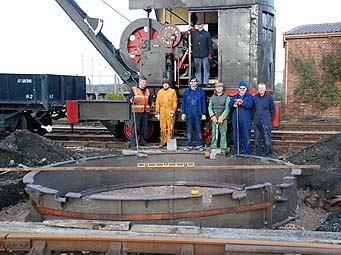
A R Hook- 31-Jan-10
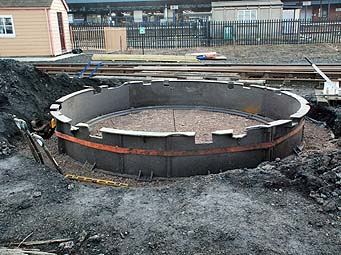
A R Hook - 31-Jan-10
The original cast iron parts were cleaned by judicious use of an angle-grinder mounted wire brush, together with hand tools, and occasional use of hammer and chisel to remove stubborn remains of concrete. We also required regular use of a crane to turn the various components over so that we could get to them. Once so cleaned the sections were painted in rust preventative paint.
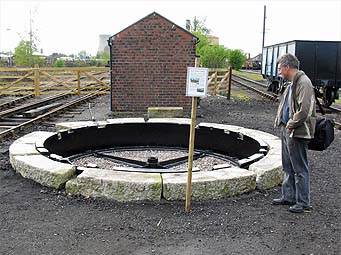
R J Heron - 24-Apr-10
This work proceeded well over the summer of 2009 so that by the early part of 2010 we were ready to start assembling some of the restored parts near to the site entrance, where the turntable was to be displayed.
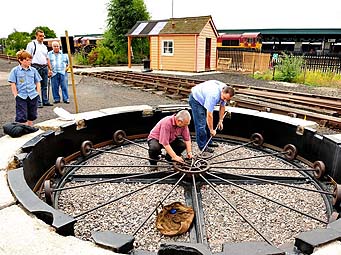
F Dumbleton- 07-Aug-10
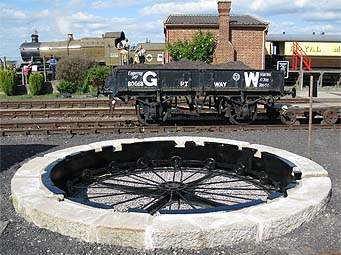
R J Heron - 21-May-11
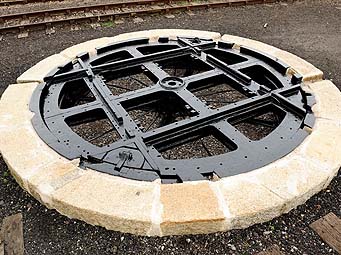
F Dumbleton - 05-August-11
In early January a hole was dug using a mini-digger that was on site for other purposes. On 31st January 2010 a geotextile membrane was laid in the hole and a layer of some four tons of building ballast placed on top to form a level well drained base. The four curved cast segments forming the edge of the turntable pit were craned into place and bolted together. As one of the segments had been found to have cracked through, the circle was temporarily held firmly together with a large cargo strap to allow some permanent steel strapping to be installed.
Once the steel straps were fitted, and the metalwork fully painted, the ground on the outside of the pit could be levelled and excess spoil removed. With this done, the site presented a tidier appearance for the Easter open days. After Easter the quarter ton granite blocks were moved loosely into place with the aid of the 5 ton steam crane. Each block then needed a degree of fettling to enable it to fit flush against the metalwork, and of course needed to be levelled and crow-barred into final position.
With the crane booked we also took the opportunity to fit the cross piece which holds the centre of the table in place.
The next phase was to reconstruct the ‘spider’ arrangement which carries the wheels which support the turntable itself. Unlike most of the structure this was originally constructed of steel which was badly wasted and therefore needed to be replaced.
The original cast iron centre boss and the sixteen carrying wheels were cleaned up and painted with rust-inhibiting paint. Sixteen rods were produced each with a 1" Whitworth thread at both ends (courtesy of Mark Baldry and the Loco Works screwing machine) and with a collar welded on in simulation of the forged original. The assemblage was the trial-erected on 7th August 2010 which then allowed the replacement curved retaining straps to be marked up and drilled. This proved to be an awkward task as the size and curvature of the metal pieces made getting them into position on the radial drill bed quite a challenge - but it was ultimately achieved. With this task completed the spider was fully assembled and painted with two coats of rust inhibiting primer and a black top coat.
The next stage was to clean up the final part of the assembly - the table itself. Like the rest of the cast-iron parts it was cleaned by chipping-off any concrete and then power wire brushing the metalwork. The metalwork thus cleaned was then painted with two coats of rust inhibiting paint and a gloss topcoat. Once the top surface of both half table castings had been painted they were turned over using one of our 5 ton cranes and the process repeated on the underside.
With the table halves cleaned and prepared, a crane was booked for 1st August 2011. The halves were turned back the right way up, transported to the installation site and placed carefully in the hole. With a little bit of ‘jiggling’ the halves were aligned so that they could be bolted together. After that a little cleaning and spot repainting was required to make the assembly look presentable once more.
All that then remained to do was to plank the deck, which turned out to be a very fiddly job, due to all the curves and the rails getting in the way!
We also worked with the GWS Education Team to produce a suitable information board, which was finally installed on 14th April 2013, drawing the turntable project to a close.
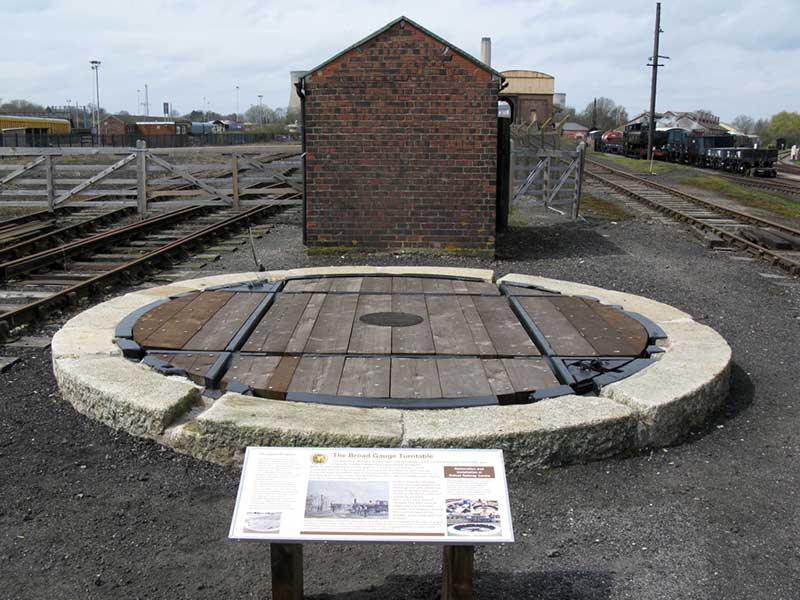
R J Heron -17-Apr-13
Bibliography
|
Burkhalter, Paul. 2002. Devonport Dockyard Railway. |
